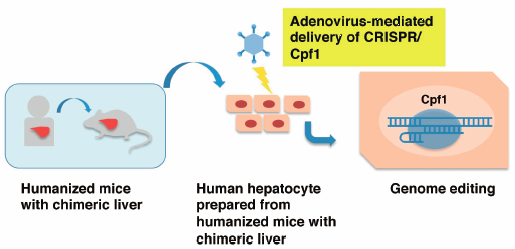- 著者
- Tomohito Tsukamoto Eiko Sakai Shunsuke Iizuka Marcos Taracena-Gándara Fuminori Sakurai Hiroyuki Mizuguchi
- 出版者
- The Pharmaceutical Society of Japan
- 雑誌
- Biological and Pharmaceutical Bulletin (ISSN:09186158)
- 巻号頁・発行日
- vol.41, no.7, pp.1089-1095, 2018-07-01 (Released:2018-07-01)
- 参考文献数
- 37
- 被引用文献数
- 16
The clustered regularly interspaced short palindromic repeats (CRISPR)/CRISPR-associated protein (Cas) 9 system is now widely used as a genome editing tool. CRISPR-associated endonuclease in Prevotella and Francisella 1 (Cpf1) is a recently discovered Cas endonuclease that is designable and highly specific with efficiencies comparable to those of Cas9. Here we generated the adenovirus (Ad) vector carrying an Acidaminococcus sp. Cpf1 (AsCpf1) expression cassette (Ad-AsCpf1) for the first time. Ad-AsCpf1 was applied to primary human hepatocytes prepared from humanized mice with chimeric liver in combination with the Ad vector expressing the guide RNA (gRNA) directed to the Adeno-associated virus integration site 1 (AAVS1) region. The mutation rates were estimated by T7 endonuclease I assay around 12% of insertion/deletion (indel). Furthermore, the transduced human hepatocytes were viable (ca. 60%) at two weeks post transduction. These observations suggest that the Ad vector-mediated delivery of the CRISPR/AsCpf1 system provides a useful tool for genome manipulation of human hepatocytes.
- 著者
- Mitsuhiro Machitani Fuminori Sakurai Keisaku Wakabayashi Kosuke Nakatani Kazuo Takayama Masashi Tachibana Hiroyuki Mizuguchi
- 出版者
- 公益社団法人日本薬学会
- 雑誌
- Biological and Pharmaceutical Bulletin (ISSN:09186158)
- 巻号頁・発行日
- vol.40, no.3, pp.272-277, 2017-03-01 (Released:2017-03-01)
- 参考文献数
- 25
- 被引用文献数
- 7
Clustered regularly interspaced short palindromic repeat (CRISPR)/Cas9-mediated genome engineering technology is a powerful tool for generation of cells and animals with engineered mutations in their genomes. In order to introduce the CRISPR/Cas9 system into target cells, nonviral and viral vectors are often used; however, such vectors trigger innate immune responses associated with production of type I interferons (IFNs). We have recently demonstrated that type I IFNs inhibit short-hairpin RNA-mediated gene silencing, which led us to hypothesize that type I IFNs may also inhibit CRISPR/Cas9-mediated genome mutagenesis. Here we investigated this hypothesis. A single-strand annealing assay using a reporter plasmid demonstrated that CRISPR/Cas9-mediated cleavage efficiencies of the target double-stranded DNA were significantly reduced by IFNα. A mismatch recognition nuclease-dependent genotyping assay also demonstrated that IFNα reduced insertion or deletion (indel) mutation levels by approximately half. Treatment with IFNα did not alter Cas9 protein expression levels, whereas the copy numbers of guide RNA (gRNA) were significantly reduced by IFNα stimulation. These results indicate that type I IFNs significantly reduce gRNA expression levels following introduction of the CRISPR/Cas9 system in the cells, leading to a reduction in the efficiencies of CRISPR/Cas9-mediated genome mutagenesis. Our findings provide important clues for the achievement of efficient genome engineering using the CRISPR/Cas9 system.
